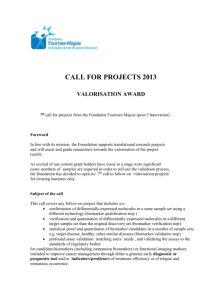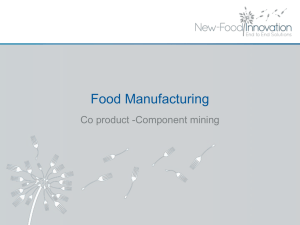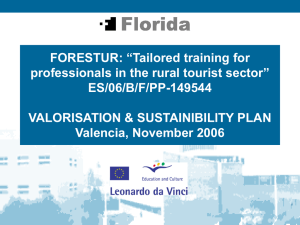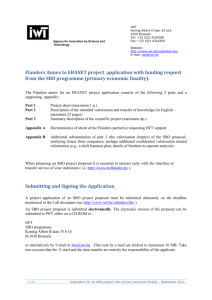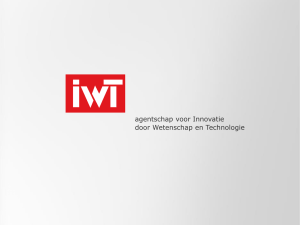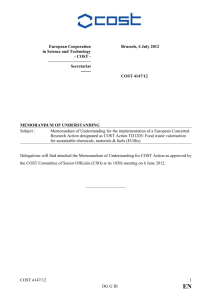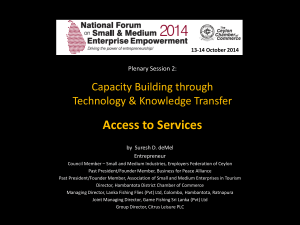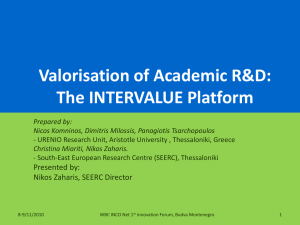PowerPoint-presentatie
advertisement
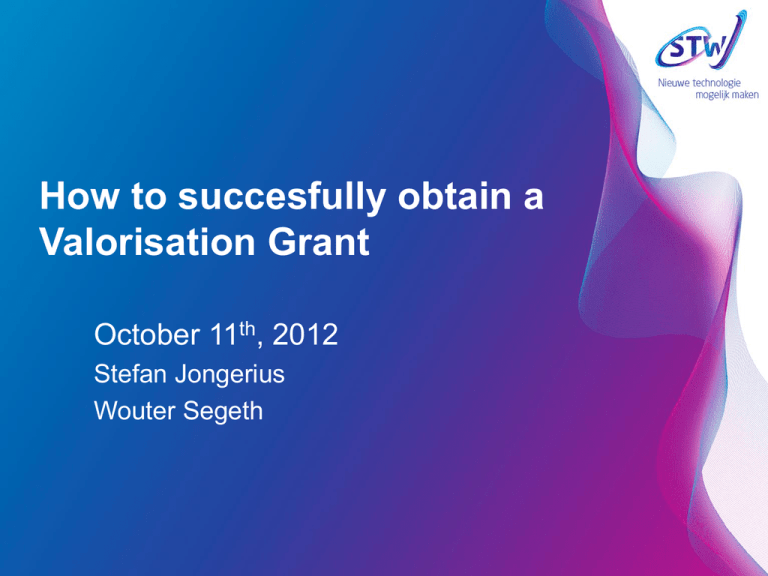
How to succesfully obtain a Valorisation Grant October 11th, 2012 Stefan Jongerius Wouter Segeth Mission STW Enabling knowledge transfer between technology driven sciences and its potential users 1. By financing excellent applied scientific research 2. By uniting scientists and potential users in research Img src: www.technologie.at Est. 1981 Current relations • 500 projectleaders • 750 researchers • 600 companies in user committees • 2500 actual user relations • 50 fte STW office employees Universities involved Erasmus 1% Institutes VU Radboud UvA 3% 3% 3% 5% RUG 5% TUD 26% UL 6% WUR 7% UU 7% UT 16% TU/e 18% Participation knowledge-institutions in STW-programs (OTP, Perspectief & Vernieuwingsimpuls) based on running projects in 2009 Topsectors Creative industry 1% Logistics 1% HTSM 45% Percentage relevance topsectors based on STW projects Life sciences & health 27% Water 4% Agrofood 3% Energie 7% Horticulture, seed materials 4% Chemistry 9% STW network Bubblechart STW network; size indicates number of proposals; relative distance indicates collaboration STW budgets € 74,7M Co-finance & transfer fees 9,5M Partnership & Valorisation Grant EL&I 23,0M Perspectief NWO other 10,5M Vernieuwingsimpuls NWO, OCW basic funding 31,7M Open Technology Program income expenses Yr. 2011 STW Instruments Perspectief • • • Vernieuwingsimpuls (NWO) • • Individual research grants Size ≤ 1,5 M€ per proposal Technology driven networks ≥ 3 universities Size: 2 - 7,5 M€ per programme 10,5M€ 23M€ 31,7M€ Open Technology Programme • • • Technology driven research projects Size: ≤ 750 k€ per project In-cash and/or in-kind contributions from users 5,5M€ 4M€ Valorisation Instruments Partnerships • • • Demand-driven programmes 50% in-cash contributions from industry Size: ≤ 3 M€ per partnership • • • Valorisation Grant Demonstrator Stimulation commercialisation of research results Financing valorisation Fundamental Research Applied Research OTP Transition Market entry Market expansion Funding intensity Valorisation Grant Government Banks Demonstrator Funding gap Venture Capital Perspectief Partnership Industry Industry Angel Investors STW valorisation Result Public Sales Private Active user Knowledge transfer Research OTP Perspectief Industry & SME Promising result Demonstrator Industry & SME HBO RAAK Active entrepreneur Valorisation Grant Start-Up & SME Valorisation Grant Phase 1: Feasability study Phase 2: Valorisation Phase 3: Commercialization • Grant up to 25.000€ • Grant up to 200.000€ • Business running • To prove the technological • Transition from public • Private funding and commercial feasibility research to private business STW Valorisation Grant Started in 2004. This program closely resembles the American Small Business Innovation Research program (SBIR). The main objectives of the Valorisation Grant are: To transfer university knowledge into business • to existing SME companies • to new companies To strengthen the innovation power of SME • high-tech innovations Valorisation Grant Public Phase 1: Feasibility study • to show technical feasibility • to show economical / commercial feasibility • maximum: 25.000 euro Phase 2: Valorisation phase • proof of concept • to raise venture capital • to serve first customers • maximum: 200.000 euro Phase 3: Commercial phase • fully commercial operating company • privately funded, no public funding Private Valorisation Grant Who can apply? Only university employees can apply However… The applicant can use the grant to start-up a company or to cooperate with an existing SME The advantage Stimulates university employees to start business activities Universities becomes much more involved in innovative SME activities Facts Valorisation Grant • Yearly budget: 3-4 million euro • 2 calls a year • Open call, no themes. • One big competition. Every applicant gets interviewed by a experienced panel of entrepreneurs, private bankers and scientists • STW is willing to transfer or license IP to company for market price Facts Valorisation Grant VG 2004-2010 Phase-1 Submitted 148 Life Sciences 127 High-tech systems 80 ICT 31 Chemistry Total 386 Granted 60 59 31 16 166 Phase-2 Submitted 45 37 26 14 122 Granted 16 20 15 4 55 Impact Valorisation Grant VG performance indicator Companies Phase 2 start-up SME 52 (96%) 2 (4%) Follow-up appplication phase 1 ► phase 1 phase 1 ► phase 2 phase 2 ► phase 3 43% 45% 50-75% Valorisation Grant start-ups Findings so far • The motivation at the university to develop your own business is high. • The entrepreneurial skills at the universities can be improved. • The incubator facilities at the universities make Valorisation Grant projects more successful • Low-entrance private seed capital makes the continuation into phase 3 relatively easy. How to write a VG phase 1 application Content 1. Contact details 2. Business idea 2.1 The problem 2.2 The proposed solution 2.3 Innovative aspects 2.4 Commercial aspects 2.5 The IP position 3. Project plan 3.1 The aim of the project 3.2 Description of work 3.3 Milestones, time schedule and cost indications 3.4 The project team 4. Budget plan Evaluation criteria: • Technological innovation (1x) • Market potential (1x) • Project plan (1x) • The team (1x) How to write a VG phase 2 application Content 1. Contact details 2. Business development plan 2.1 The business idea 2.2 The product development plan 2.3 Market and competition 2.4 Business organisation 2.5 IP position and strategy 3. Project plan Evaluation criteria: 3.1 The aim of the project • Technological innovation (1x) 3.2 Description of work • Market potential (1x) 3.3 Milestones and time schedule • Project plan (2x) and cost indications • The team (2x) 3.4 The project team 4. Budget plan
